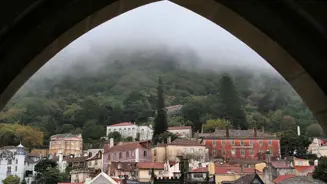1 November: the earth also shook in Sintra on All Saints' Day
01 Nov 2023
1 November is All Saints' Day, a public holiday in Portugal and a celebration of all the Catholic saints and martyrs. According to records that have survived to the present day, the origin of this celebration dates back to the 7th century, under Pope Boniface IV.
In relation to Sintra, the chronicler Damião de Goes wrote that between October and December 1498, King Manuel I passed through the Palace of Sintra and organised great festivities for the Holy Days.
'On Sundays and Holy Days (...) He often ordered bullfights to be run and a type of jousting. So that the noblemen wouldn't spend too much of their [material goods] on these games, he would lend them Moorish implements and clothes to use. At times he participated in the jousting game, which he played very well and very gracefully. His arms were so strong that besides being very good on horseback, he threw a lance or a spear with such dexterity that no other man could beat him,' writes Damião de Goes.
Although there is no direct reference to All Saints' Day in this passage, it is plausible that it was this date being marked at this time in the Palace of Sintra.

Dois séculos depois deste testemunho – se formos mais específicos, 257 anos depois, em 1755 –, um sismo destruiu quase toda a cidade de Lisboa. Seguiu-se um maremoto e vários incêndios. Estima-se que o terramoto tenha atingido uma magnitude entre os 8,7 e os 9 na escala de Richter. É impossível saber ao certo o número de mortos, mas, de acordo com o site do Museu do Terramoto de Lisboa, “a maioria dos estudos concorda que o número de mortes se tenha situado muito provavelmente entre as 12 000 e as 40 000”, numa altura em que a capital tinha cerca de 200 mil habitantes.
O terramoto também foi sentido em Sintra. “Na Villa de Cintra cahiu a Igreja Collegiada de S. Martinho, e deixou mortos o seu prior (…), e mais 24 pessoas. O mesmo successo teve a Igreja, e Casa da Misericorida. O Paço Real da mesma Villa ficou bastantemente arruinado, excepto a belíssima Casa da Armaria da Nobreza, feita pelo Senhor Rey D. Manoel; e renovada pelo Senhor Rey D. João V. (…) Passarão de 73 pessoas, que morrerão nesta Villa.”, escreveu, em 1758, três anos após o grande sismo, Joaquim José Moreira de Mendonça, autor da ‘História Universal dos Terramotos’.
Mais tarde, António Dâmaso de Castro e Sousa – mais conhecido como Abade de Castro – detalhou os estragos provocados pelo terramoto no Paço de Sintra: “Pelo terramoto do 1º de Novembro do anno de 1755 soffreu este Palácio grave ruína, e com especialidade esta sala (Cisnes), a qual foi reparada por ordem de ElRei D. José; deteriorando-se por esta occasião muito da sua antiga architectura: como ainda se póde ver pela planta tirada por Duarte d´Armas [última imagem]”, relatou, em 1838, na obra sobre o 'Palácio de Sintra, Mosteiro da Nossa Senhora da Pena e Castelo de Sintra’.
Uma curiosidade: é também no dia 1 de novembro que se pede ‘Pão-por Deus’. Neste dia, as crianças saem à rua e vão de porta em porta pedir ‘Pão-por-Deus’ – em troca, recebem pão, frutos secos, romãs, doces e há atém quem dê ‘umas moedinhas’. Em algumas zonas do país, este dia é conhecido como ‘Dia do Bolinho’. Em 1756, um ano após o terramoto, a tradição manteve-se em Lisboa e todos saíram à rua para pedir ‘Pão-por-Deus’.
